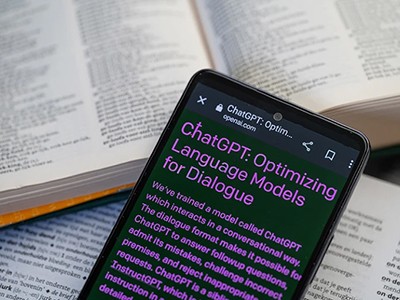
Credit score: Laurence Dutton/Getty
“As of my final information replace”, “regenerate response”, “as an AI language mannequin” — these are just some of the telltale indicators of researchers’ use of synthetic intelligence (AI) that science-integrity watchers have discovered sprinkled by means of papers within the scholarly literature.
3 ways ChatGPT helps me in my educational writing
Generative AI instruments similar to ChatGPT have rapidly reworked educational publishing. Scientists are more and more utilizing them to arrange and assessment manuscripts, and publishers have scrambled to create pointers for his or her moral use. Though insurance policies differ, many publishers require authors to reveal the usage of AI within the preparation of scientific papers.
However science sleuths have recognized lots of of instances through which AI instruments appear to have been used with out disclosure. In some instances, the papers have been silently corrected — the hallmark AI phrases eliminated with out acknowledgement. This kind of quiet change is a possible risk to scientific integrity, say some researchers.
Such modifications have appeared in a “small minority of journals”, says Alex Glynn, a analysis literacy and communications teacher on the College of Louisville in Kentucky. However on condition that there are in all probability additionally many instances through which authors have used AI with out leaving apparent indicators, “I’m shocked by how a lot there may be”, he provides.
‘I’m an AI language mannequin’
Since 2023, integrity specialists have flagged papers with apparent indicators of undisclosed AI use, similar to those who include the phrase “regenerate response”, generated by some chatbots based mostly on massive language fashions when a person desires a brand new reply to a question. Such phrases can seem in articles when an creator copies and pastes a chatbot’s responses.
Scientific sleuths spot dishonest ChatGPT use in papers
One of many first instances that Glynn remembers seeing was in a now-retracted paper revealed in 2024 in Radiology Case Experiences1 that contained the chatbot phrase “I’m an AI language mannequin”. “It was as blatant because it might presumably be,” Glynn says. “In some way this handed not solely the authors’ eyes, however the editors, reviewers, typesetters and everybody else who was concerned within the manufacturing course of.”
Glynn has since discovered lots of extra papers with hallmarks of AI use — together with some containing subtler indicators, such because the phrases, “Actually, listed here are”, one other phrase typical of AI chatbots. He created a web based tracker, Academ-AI, to log these instances — and has greater than 700 papers listed. In an evaluation of the primary 500 papers flagged, launched as a preprint in November2, Glynn discovered that 13% of those articles appeared in journals belonging to massive publishers, similar to Elsevier, Springer Nature and MDPI.
Artur Strzelecki, a researcher on the College of Economics in Katowice, Poland, has additionally gathered examples of undisclosed AI use in papers, specializing in respected journals. In a examine revealed in December, he recognized 64 papers that had been revealed in journals categorized by the Scopus educational database as being within the high quartile for his or her subject3. “These are locations the place we’d count on good work from editors and first rate critiques,” Strzelecki says.
‘Clearly ChatGPT’ — how reviewers accused me of scientific fraud
Nature’s information crew contacted a number of publishers whose papers had been flagged by Glynn and Strzelecki, together with Springer Nature, Taylor & Francis and IEEE. (Nature’s information crew is editorially impartial of its writer, Springer Nature.) All mentioned that the flagged papers are beneath investigation. In addition they pointed to their AI insurance policies — which, in some instances, don’t require disclosure of AI use or require it just for sure makes use of. Springer (owned by Springer Nature), for instance, states that AI-assisted copy modifying, which incorporates modifications made for readability, type, and grammar or spelling errors, needn’t be flagged.
Kim Eggleton, head of peer assessment and analysis integrity at IOP Publishing in Bristol, UK, notes that though the writer launched a coverage requiring authors to declare AI use in 2023, it modified the foundations final 12 months to mirror the ubiquity of the instruments. “Whereas we encourage authors to reveal the usage of AI, it’s not mandated,” Eggleton says. “We’re specializing in guaranteeing the accuracy and robustness of the content material by means of a mix of automated and human checks, fairly than prohibiting AI fully.” IOP’s coverage does, nevertheless, prohibit the usage of AI to “create, alter or manipulate” analysis information or outcomes.


